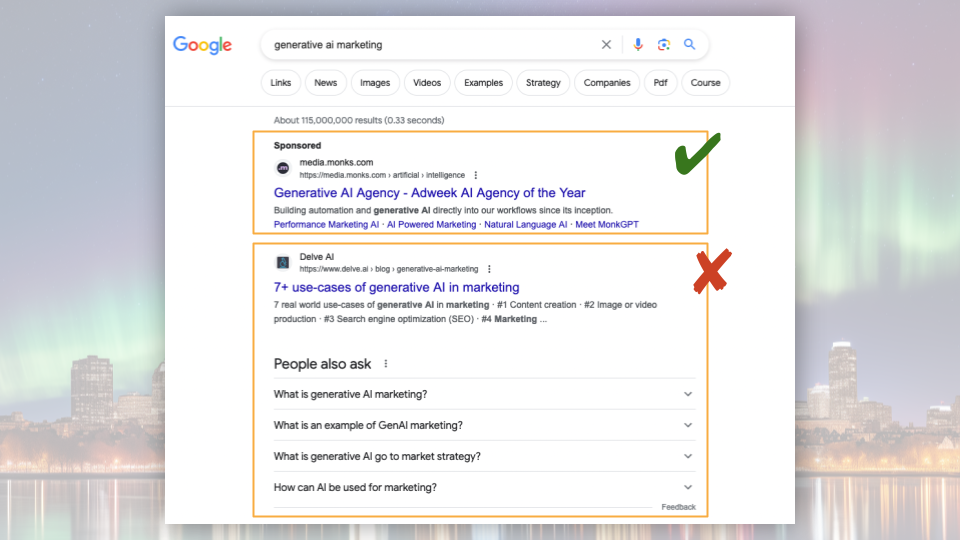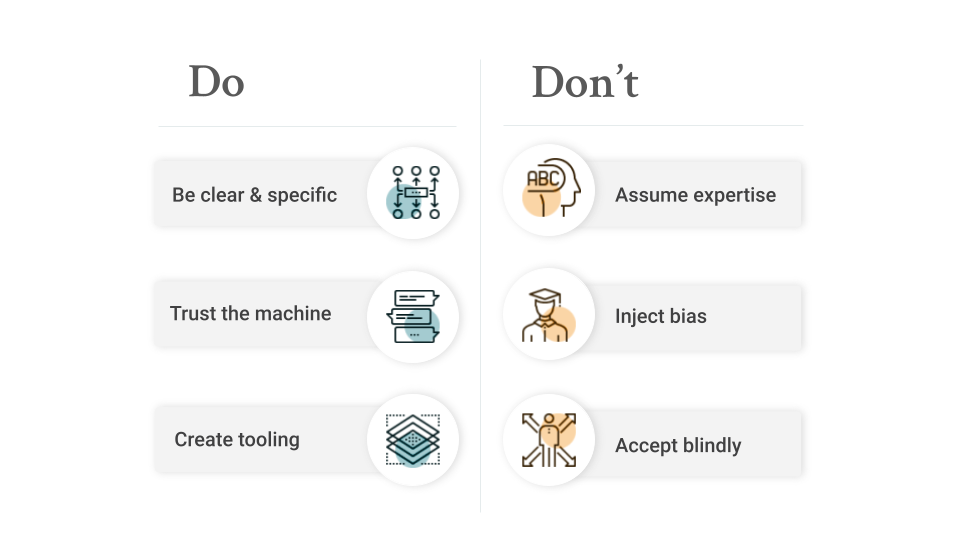Copywriters, you may want to cover your ears for this hard truth about search advertising–-Words are losing relevance. Google’s SEM ecosystem is more complex than ever, with an engine that prioritizes being in the right place at the right time over clever creative. How should marketers respond, then, when Google’s robots emphasize automation and segmentation over a pithy headline?
With our own robots, of course.
In this 20-minute webinar, Altitude’s Chief Strategy Officer Adam Smartschan explores GenAI’s new role in search advertising. Watch now to learn why manual search ad creative is quickly becoming obsolete, how GenAI helps you target the right people (without bias), and practical ways you should (and should not) use the technology to boost your SEM conversion.
GenAI and Search Advertising
What is Search Advertising?
Before firing up your ChatGPT, we need to level-set on what we’re talking about when we say “search advertising.” Sometimes called PPC (pay-per-click) or SEM (search engine marketing), it’s everything that lives at the top of the results page—anything with the “sponsored” label above it.
You are paying money to appear in a prominent position in front of the right people based on the keyword they’ve plugged into the search engine.

Within just the past year, Google’s search-ad ecosystem has become a lot more complex. It’s a $65 billion-a-year industry that’s exploded in both tactical complication and bidding competitiveness. We’ve seen the most significant changes in three ways:
You Have Less Manual Control:
Marketers no longer have granular control over the exact words, phrases, or content matches they want to target. Google is now relying more on its own AI to show your ad to users it thinks are the best match. Even on the creative side, Google will match what it believes is the best possible title and description combo to the end user, only using your copy as a general set of options to mix, match, or re-arrange.
Extreme Personalization:
Google wants to deliver each user as tailored an experience as possible. No longer can you, as the marketer, guarantee that a specific headline and a specific website description will appear in a specific order to a specific user. Google believes it can do it better–and it relies on its own predictive analytics and machine learning to do so.
Extended Reach:
It used to be that Google Search ads lived in Google Search, YouTube ads lived in YouTube, and so on. With the launch of its integrated ad product “Performance Max,” marketers can now control and deliver their message across Alphabet’s suite of products. In a sense, then, the marketer is only offering a suggestion of the message they want displayed, letting Google’s machines deliver the final product in the format it believes is the most effective.
Why Use GenAI in Search Advertising?
With so much of Google’s ad interface and content delivery out of human hands, the question remains: Why would marketers not adopt AI-driven workflows? If Google trusts the robots, you should too.
There used to be far fewer search ads on every results page, and when they appeared, they often weren’t 100% relevant to the search keyphrase. When that was the case, the actual creative–each specific word–of the ad mattered. You could increase your click-through-rate through small tweaks.
That artistry needed a human touch, but it’s an artistry that no longer applies. Now, ad real estate isn’t just crowded; it’s dictated by what Google thinks the user wants. That means the creative matters less than the location. The search ad is effectively a form of behavioral targeting–if someone searches for “x,” you need to be there. You need to maximize your visibility rather than agonize over phrasing.
Your words, then, cannot effectively increase CTR. But they can decrease CTR.
How can you avoid that? GenAI.
We like to think of GenAI as the “mean of humanity.” That means it may not give you the exact right answer every time, but it will give you the average answer. And when it comes to search advertising–in particular, how your advertising is displayed–the average answer is exactly what Google wants.
3 Practical Ways to Use GenAI in Search Advertising
Put to work correctly, GenAI is like a great intern. During your strategic planning and content generation process for search ad campaigns, tools like ChatGPT will help you… Do more. With Less. Faster.
We see the impact most in these three essential PPC steps.
Keyword Research
You bring significant subject matter expertise to ad workflows. As a marketer–or even a company executive or innovator–you know more about the topic you’re trying to message than the audience you are trying to reach. That’s great when you can control the terms of a conversation–when, where, and how it’s presented.
In search advertising, though, you cannot control the keywords or phrases your target customers use. Therefore, you actually introduce significant bias to the table. For example, you know the technically correct term for a complex scientific testing process. But, do your customers? Will they spell that process correctly, or even search for that exact phrase?
Some example prompts include:
- Defining keywords by persona: “What keywords would a CTO use to find the best cloud storage company.”
- Keyword expansion: “What are other examples of keywords like ‘the best cloud storage company.’
- Persona building: “What are the job titles of someone who needs to search for the best cloud storage company.”
The results of these prompts may not be 100% accurate or incredibly sophisticated, but they don’t need to be. You are looking for an average answer at scale–a task that AI performs exceptionally well.

Creative at Scale
Five years ago, you probably agonized over every word of every search ad. With keyphrase specificity and Google’s personalization, you simply don’t have time to hand-curate every single variant of a search ad. But GenAI can, at an incredibly fast pace.
Google’s AI effectively picks the right message for the right user. Even mass-market AI tools use very similar data sets and methodologies. Your GenAI tool then, will do a decent job at writing creative. But it will do it insanely fast.
That doesn’t mean you should be fully removed from the process. But it’s far quicker to review 100 headlines produced by a machine than write them yourself from scratch.
Rich Data Analysis
Feeding a .csv to ChatGPT is really simple, and won’t just save you time when analyzing a set of numbers. It will help keep your attention and takeaways at a high (and more useful) level. You can start simple and still get valuable insight.
Questions like: “What’s most important in this data set?” or “What trends do you see?” can yield useful information in seconds–rather than the hours you’d spend digging into the information yourself.
Conclusion: The Robots are Here. You Still Need to Guide Them
We’d argue GenAI in search advertising is no longer a bleeding-edge curiosity. It’s a necessity. That being said, there are three important factors to keep in mind:
Things Have Changed: PPC used to be much more about delivering a specific message. Now it’s basically behavioral targeting for AI-powered creative.
Robots are in Charge: Google trusts its AI implicitly to deliver a positive UX. You should trust yours to interface with it in ways you can’t
You Still Matter: Remember to offload tasks to AI but don’t let it drive strategy. The most efficient workflows can’t fix a bad process or value proposition.



